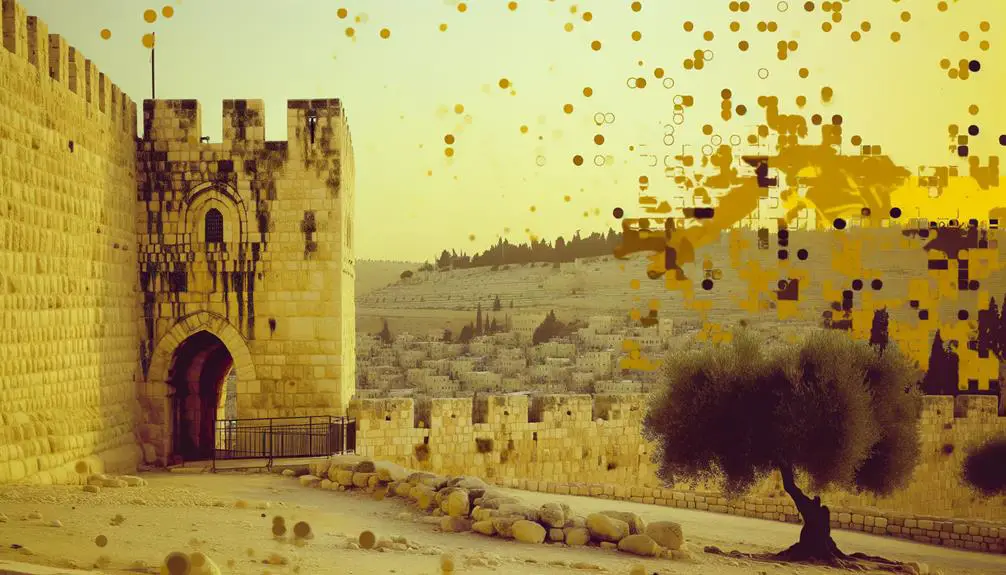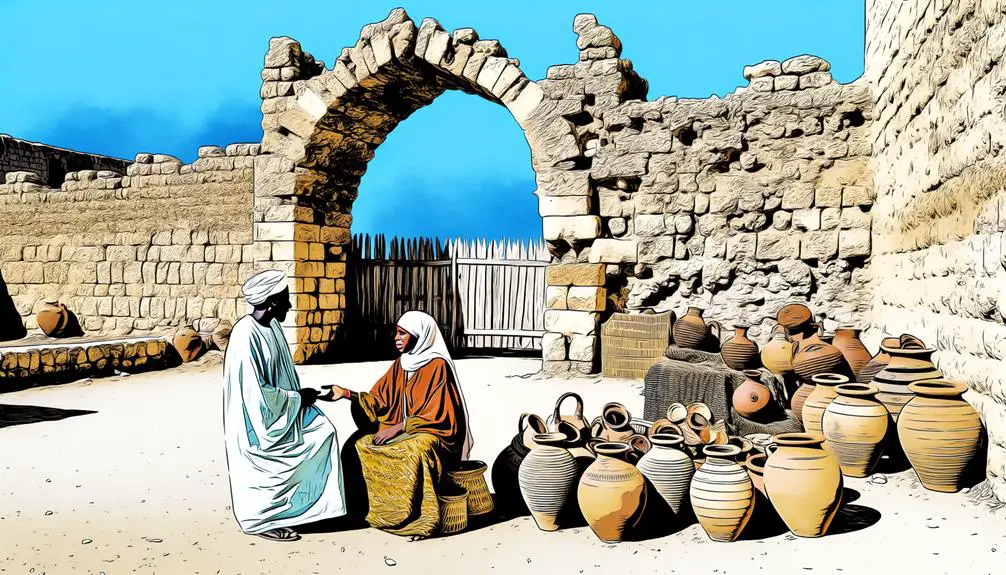Learn about the profound symbolism of gates in the Bible, revealing shifts in divine interaction and societal structure—discover what lies beyond.

Gates in the Bible
In the Bible, gates hold significant symbolic importance, signaling changes, divine interactions, and societal structures. They often mark shifts, such as the Gates of Eden which embody moral consciousness and the profound effects of choices. Jerusalem's gates, on the other hand, reflect themes of protection, communal identity, and historical continuity. Their strategic roles in defense and ceremonies underline their utility and sacredness. Gates are depicted as centers of judgment and governance, particularly in Proverbs, where city gates serve as venues for important societal decisions. Exploring the multifaceted roles and meanings of gates can offer deeper insights into biblical narratives and symbols.
Key Takeaways
- Gates in the Bible symbolize transitions, such as moving from sin to redemption or the mundane to the divine.
- Biblical gates often serve as settings for significant events, including divine encounters and prophetic revelations.
- The Gates of Jerusalem highlight themes of protection, communal identity, and governance within the city.
- The twelve gates of the Heavenly City represent different types of believers and signify purity and transformative faith journeys.
- Gates can also signify exclusion and divine judgment, marking boundaries that only the worthy can cross.
The Significance of Biblical Gates

In biblical narratives, gates aren't just physical structures; they're pivotal in the unfolding of theological and communal events. As you explore the scriptures, you'll notice that gate metaphors often symbolize beginnings, changes, and divine encounters. Each gate, whether it be the gates of Jerusalem or the metaphorical gates in visions and prophecies, holds a significant role that is essential to understanding the broader narrative.
Consider the gates of Nehemiah's Jerusalem. These weren't merely city entrances; they represented restoration and protection, both physically and spiritually. During the rededication ceremony, the Levites purified themselves, the people, the gates, and the wall, underscoring the gates' role in consecration and communal identity. This ceremonial aspect emphasizes that gates functioned as thresholds between the mundane and the sacred.
Moreover, gate metaphors extend to wisdom and authority. Proverbs positions the gates as a place where elders dispense justice and wisdom, suggesting that gates are not just passageways but are pivotal arenas for governance and societal order. Therefore, when you read about gates in the Bible, you're encountering nodes of power, judgment, and divine interaction, each weaving a rich tapestry of symbolism and function that reinforces their transcendent and communal significance.
Gates of Eden: Beginnings
Reflecting on the profound roles of gates in biblical narratives, consider the Gates of Eden, which mark humanity's initial encounter with divine boundaries and beginnings. These gates aren't merely physical constructs but also symbolize the commencement of human moral consciousness and the delineation between sacred and profane spaces. You'll find that the Gates of Eden fundamentally represent the threshold beyond which humanity first exercised free will and faced the consequences of their actions.
The narrative intricately weaves the theme of Garden access, emphasizing how the gates both permit and restrict entry into this utopic space. Initially, these gates offered unfettered access to Adam and Eve, embodying a divine trust and liberty. However, the serpent's entry through these gates—or perhaps a breach of this threshold—ushers in a pivotal transformation. This act not only signifies the cunning intrusion of evil but also marks the beginning of mankind's enduring struggle between purity and sin.
Analyzing the theological implications, the gates here are not just architectural features but are laden with symbolic weight. They stand as a constant reminder of paradise lost and the rigorous moral landscape that humanity navigates, a theme that resonates throughout the tapestry of biblical stories and human history.
The Gates of Jerusalem

As you explore the Gates of Jerusalem, it's essential to ponder their historical significance, which is deeply intertwined with the city's tumultuous past and its pivotal role in various epochs. You'll find that the architectural features of these gates provide a tangible reflection of the era's design sensibilities and technological advancements. Additionally, understanding the biblical references associated with these gates enriches your grasp of their symbolic importance in religious texts.
Historical Significance
Exploring the Gates of Jerusalem reveals their crucial role in the city's defense, commerce, and religious practices throughout history. You'll find that gate ceremonies were not merely symbolic but pivotal in asserting control and sanctifying the city's entrances and exits. These rituals often involved dedications and blessings which underscored their spiritual and communal significance.
Additionally, the frequent gate renovations throughout the centuries highlight their importance in maintaining not only the physical security of Jerusalem but also its aesthetic and functional integrity. Each renovation reflects a response to the evolving needs and threats faced by the city, demonstrating a continuous commitment to fortification and modernization. This strategic approach ensured that Jerusalem adapted to both the challenges and opportunities presented by changing historical landscapes.
Architectural Features
The architectural design of Jerusalem's gates showcases a blend of functionality and symbolic artistry, deeply rooted in the city's historical and cultural fabric. You'll notice that the gate materials often include large, carefully quarried stones, chosen for their durability and strength. These stones were typically set without mortar, relying on sheer weight and precision cutting to guarantee stability and security.
In terms of construction techniques, ancient craftsmen employed advanced engineering methods, including the dovetailing of stones and the use of metal clamps to enhance structural integrity. Each gate was strategically positioned to serve not only as a point of entry but also as a defensive mechanism. This dual purpose is evident in the meticulous attention to detail in their construction, reflecting a deep understanding of both architectural and military needs.
Biblical References
Throughout the Scriptures, you'll find that the entrances of Jerusalem are often referenced, symbolizing both literal and spiritual thresholds. These entrance metaphors serve as focal points in biblical narratives, illustrating threshold spaces where divine interactions and pivotal moments occur. For example, the Old Covenant frequently uses entrances to depict protection and communal gathering, signifying strength and unity within the city walls. In the New Covenant, entrance parables, such as the narrow entrance in Matthew 7:13-14, challenge believers to reflect on the rigor and commitment required for spiritual entry into the Kingdom of Heaven. Each reference to an entrance not only enriches the historical context but also deepens the theological implications, inviting you to explore layers of meaning in your spiritual journey.
Encounters at the City Gates

Many significant biblical events occurred at city gates, where elders met, prophets spoke, and judgments were rendered. These gateways served not just as physical passageways but also as pivotal social and economic hubs. You'd find that these locations were often bustling with various activities integral to ancient urban life.
The gates were commonly the venue for market negotiations. This was where merchants and traders converged, discussing and haggling over prices of goods ranging from spices to textiles. The dynamics of these interactions were pivotal, as they influenced economic stability and resource distribution within the city. Analyzing these negotiations provides insights into the socio-economic frameworks and the value systems of ancient societies documented in the Bible.
Furthermore, city gates were central to social gatherings. Here, information was exchanged, and communal decisions were made. Elders and city officials often used these gatherings to address the populace, implement legal decisions, and resolve conflicts. Such assemblies underscored the gates' role in maintaining civic order and fostering community relationships.
These encounters at the gates highlight their importance not just as mere entries or exits but as central epicenters of judicial, economic, and social life in biblical times.
Gates in Prophetic Visions
While city gates were centers of activity and decision-making, they also figure prominently in prophetic visions, symbolizing deeper spiritual truths and divine revelations. These gates aren't just physical structures; they're visionary thresholds that mark the passage from the seen to the unseen, from the mundane to the divine. As you explore deeper into the scriptures, you'll find that these symbolic entrances serve multiple purposes in the narrative of prophecy.
Here's how gates function in prophetic visions:
- Access Control: Just as city gates controlled who entered and exited, gates in visions often determine who can access spiritual domains. They stand as guardians, not just of cities, but of spiritual truths.
- Point of Passage: They mark critical transitions in the narrative. Entering through these gates can signify a prophet's movement from earthly concerns to divine encounters.
- Symbol of Authority: Gates often represent divine authority. Passing through them can symbolize receiving God's commission or judgment.
- Revelatory Significance: These gates sometimes reveal specific messages or prophecies. They aren't just passageways but are imbued with symbolic significance that underscores the revelation being imparted.
As you explore these visions, consider how these entrances shape the understanding of divine interaction and prophetic messages.
Symbolism of Gates in Revelations

As you explore the symbolism of gates in the Book of Revelation, consider how they serve as boundary points, not only physical but also spiritual thresholds within the narrative. The depiction of the Heavenly City's twelve gates, each crafted from a single pearl, offers profound insights into notions of purity and access in the eschatological framework. Additionally, these gates symbolize protection and exclusion, delineating who may enter and who is barred, encapsulating a dual theme of salvation and judgment.
Gates as Transition Points
In the Book of Revelation, gates symbolize pivotal crossing points where earthly domains meet divine promises, guiding your journey through spiritual revelations and transformations. These thresholds aren't just physical but are deeply emblematic, rich with gate metaphors and ceremonial passages. Here's what you might envision:
- The Gate as a Portal: Envision stepping from the chaos of earthly trials into a structured, divine order.
- The Threshold of Judgment: Each gate represents a test of faith, a place where decisions are made, reflecting your spiritual state.
- The Entry into New Territories: Passing through these gates signifies entering new phases of spiritual enlightenment and understanding.
- The Closure Behind You: Each gate closes off the past, encouraging a focus on the progression towards spiritual perfection.
Heavenly City's Twelve Gates
The symbolism of the twelve gates in the Heavenly City, as depicted in the Book of Revelation, reflects a profound spiritual taxonomy, categorizing the types of believers who enter through each gate. Each gate, uniquely crafted from a single pearl, signifies not only purity and rarity but also the transformative journey of faith each believer undergoes. The gate materials, specifically the pearls, are emblematic of precious, hard-won spiritual truths.
Surrounding these gates, angelic guardians stand, not merely as sentinels but as representatives of divine authority and protection. Their presence underscores the sanctity and exclusivity of the entrance to the Heavenly City. Each guardian, by their very role, emphasizes the seriousness and privilege of entering such a sacred space, ensuring that only those deemed worthy can pass through.
Protection and Exclusion Symbolism
Exploring the symbolism of gates in Revelation reveals a dual theme of divine protection and selective exclusion, emphasizing that access to the Heavenly City is both a privilege and a meticulously guarded process. The gate metaphors serve as stark illustrations of these principles:
- Impenetrable Walls: Symbolizing divine safeguarding, the gates are described as not just barriers but fortifications against any form of spiritual decay.
- Selective Entry: Only those deemed worthy, having their names in the Lamb's book of life, may enter, underscoring the exclusion principles.
- Closed Doors: Representing finality in judgment, once closed, these gates do not reopen, illustrating irreversible divine decree.
- Guardian Angels: Positioned at each gate, these figures are not merely ceremonial but are active enforcers of the city's sanctity.
Frequently Asked Questions
How Many Gates Are Mentioned in the Entire Bible?
You're exploring how gate symbolism and functions permeate literature and history. In the Bible specifically, numerous gates are mentioned, reflecting their symbolic and functional roles in ancient narratives and societal structures.
Were Gates Named After Specific Biblical Characters?
You're exploring whether gates were named after biblical characters. Analyzing gates' symbolism and characters' significance, it's clear that while names often carry symbolic meaning, they don't typically honor specific biblical individuals directly.
What Materials Were Used in Constructing Biblical Gates?
In ancient construction techniques, materials like wood, bronze, and iron were often used in gate construction, symbolizing strength and security. These choices reflect not just utility but also deep symbolic significance in architectural design.
Which Biblical Figure Is Most Associated With Gates?
You're exploring gate symbolism and narratives, where Nehemiah stands out. His role in rebuilding Jerusalem's gates deeply symbolizes protection and restoration, showcasing pivotal leadership in gate-related biblical narratives.
Are There Any Lost or Undiscovered Gates Mentioned in the Bible?
As the adage goes, "Every closed door hides a secret." In your search for gate symbolism, no definitive archaeological evidence suggests lost or undiscovered gates, leaving their existence more speculative than factual.

Sign up